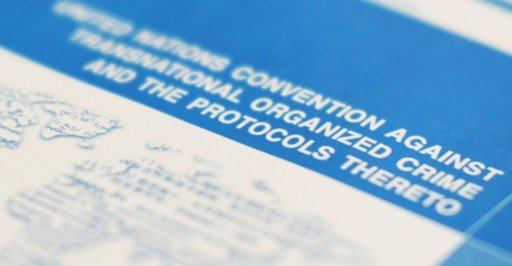
UN Convention Against Transnational Organized Crime
United Nations Convention against Transnational Organized Crime and the Protocols Thereto
The United Nations Convention against Transnational Organized Crime, adopted by General Assembly resolution 55/25 of 15 November 2000, is the main international instrument in the fight against transnational organized crime. It opened for signature by Member States at a High-level Political Conference convened for that purpose in Palermo, Italy, on 12-15 December 2000 and entered into force on 29 September 2003. The Convention is further supplemented by three Protocols, which target specific areas and manifestations of organized crime: the Protocol to Prevent, Suppress and Punish Trafficking in Persons, Especially Women and Children; the Protocol against the Smuggling of Migrants by Land, Sea and Air; and the Protocol against the Illicit Manufacturing of and Trafficking in Firearms, their Parts and Components and Ammunition. Countries must become parties to the Convention itself before they can become parties to any of the Protocols.
The Convention represents a major step forward in the fight against transnational organized crime and signifies the recognition by Member States of the seriousness of the problems posed by it, as well as the need to foster and enhance close international cooperation in order to tackle those problems. States that ratify this instrument commit themselves to taking a series of measures against transnational organized crime, including the creation of domestic criminal offences (participation in an organized criminal group, money laundering, corruption and obstruction of justice); the adoption of new and sweeping frameworks for extradition, mutual legal assistance and law enforcement cooperation; and the promotion of training and technical assistance for building or upgrading the necessary capacity of national authorities.
The Protocol to Prevent, Suppress and Punish Trafficking in Persons, especially Women and Children à It is the first global legally binding instrument with an agreed definition on trafficking in persons, in order to facilitate convergent national approaches with regard to the establishment of domestic criminal offences, international cooperation in investigating and prosecuting and assistance to the victims of trafficking in persons.
The Protocol against the Smuggling of Migrants by Land, Sea and Air à A major achievement of the Protocol was that, for the first time within a global international instrument, a definition of smuggling of migrants was developed and agreed upon.
The Protocol against the Illicit Manufacturing of and Trafficking in Firearms, their Parts and Components and Ammunition à It is the first legally binding instrument on small arms that has been adopted at the global level. By ratifying the Protocol, States make a commitment to adopt a series of crime-control measures and implement normative provisions in their domestic legal order.
News
Looking at the past to understand the future. Part two
A summary blog on last year's first Constructive Dialogue on the Smuggling of Migrants.
02 Oct, 2023
Looking at the past to understand the future. Part one
02 Oct, 2023
Call for Applications: 11th Session of the Conference of the Parties (COP) to the UNTOC
The deadline is midnight time Sunday 12 June 2022 at 00:00 CET (Vienna time). We recommend that you apply upon receiving this call, even if your participation is not yet certain, as there will not be the possibility to apply at a later stage. Please note that the application letter should be placed on a letterhead of your organization and signed by the Head of your organization.
24 May, 2022